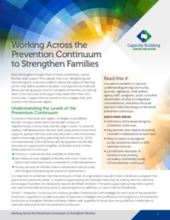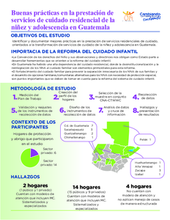Demographic Data:
|
Sources: World Bank, UNICEF, UNDP HDR 2015, DHS 2013/2014 |
Displaying 2891 - 2900 of 14348
See what an integrated, comprehensive, prevention-focused approach looks like along a three-tiered prevention continuum.
Read about the value of collaboration as the key to prevention, safety, and long-term stability for children and families.
Respuestas de niñas, niños, adolescentes y jóvenes a una encuesta mundial para el Día de Debate General 2021 sobre los Derechos del Niño y el Cuidado Alternativo
Réponses d’enfants et de jeunes à une enquête mondiale en vue de la Journée de débat général sur les droits de l’enfant et la protection de remplacement 2021
The purpose of this review is to explore how UNICEF country offices have used Public Finance for Children (PF4C) analyses and interventions within child protection, with a view to learning lessons from their experiences.
This document serves as a guiding framework for those involved in the development of comprehensive national Care Systems as a pillar of social protection in Latin American and the Caribbean. The authors believe that these systems should be designed from a human rights perspective, with particular emphasis on mainstreaming the gender perspective to achieve care models co-responsible between the State, the market, the community, and families, and between men and women.
This document outlines 5 key steps that serve as an effective blueprint for a successful reintegration process of children and disabilities. These include ‘engagement’, ‘Assessment’, ‘Design & Development’, ‘Transition’, and ‘Monitoring & Evaluation’.
This report presents the findings from the National Survey of Residential Centres for Children with Disabilities in Rwanda. The survey aimed at gathering comprehensive and disaggregated data related to residents’ characteristics, staff profile, and the minimum standards for the centres.
This study is part of the response to the global call for the provision of quality alternative family-based care and prevention of family separation for children with disabilities. The study is premised on the view that the knowledge, attitudes, and practices regarding the attributes assigned to, and the conceptualization of, children with disabilities in their families and communities, vis-à-vis institutional care for children with disabilities, are also crucial determinants of barriers/ enablers of full and meaningful integration of children with disabilities into community life in Rwanda.
OBJETIVOS DEL ESTUDIO: Identificar y documentar mejores prácticas en la prestación de servicios residenciales de cuidado, orientados a la transformación de servicios de cuidado de la niñez y adolescencia en Guatemala.










